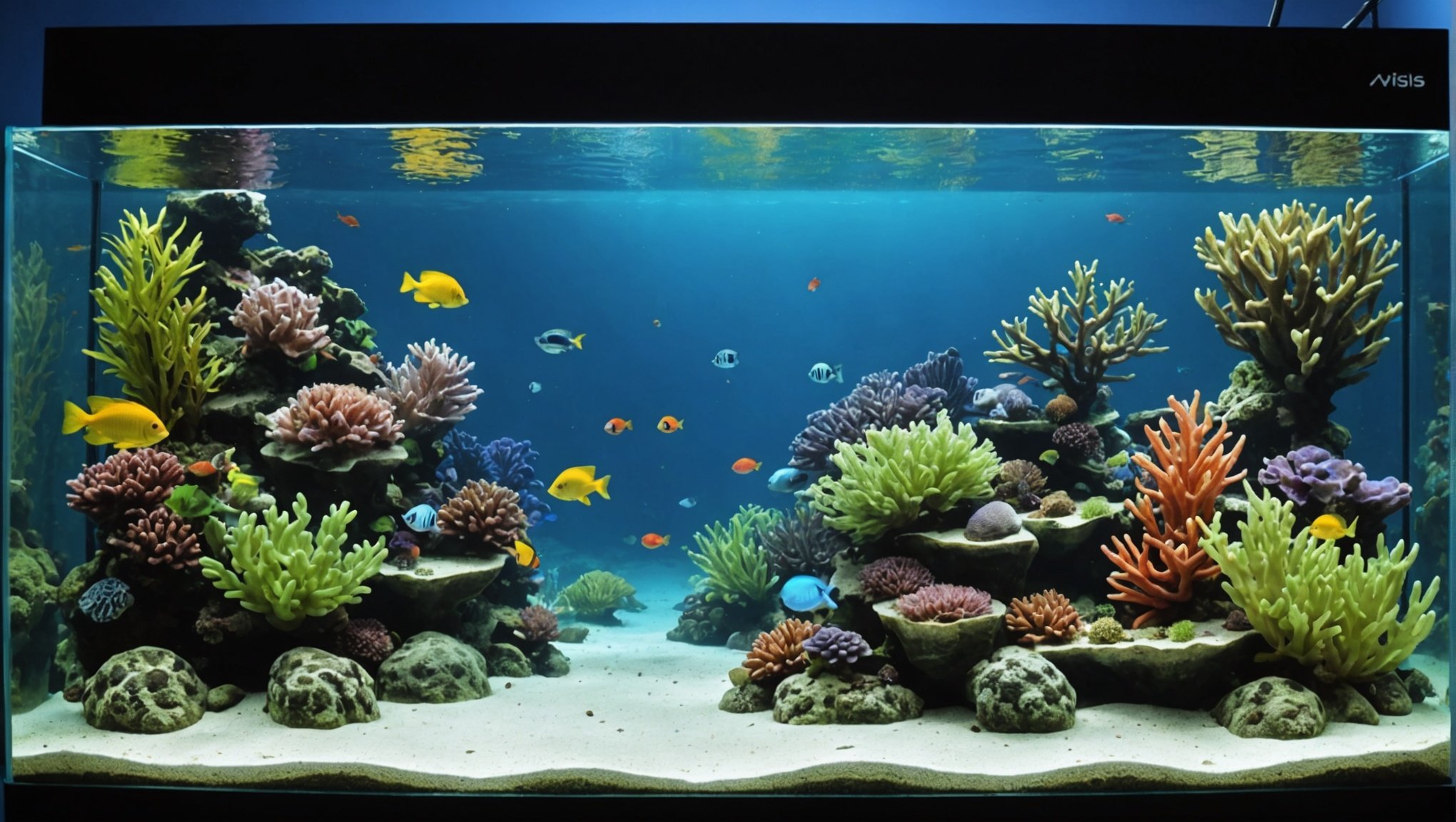Overview of Effortless Aquarium Design
In today’s fast-paced world, crafting an aquarium that requires minimal intervention is a boon for busy homeowners. Effortless aquarium design emphasizes self-sustaining systems—a method where the ecosystem maintains itself with minimal external input. This approach is not only time-saving but also allows aquarists to enjoy their aquatic haven without constant upkeep.
Creating a self-sustaining aquarium relies on a balance of plant life, microorganisms, and fish. Plants play a crucial role by oxygenating the water and providing food for herbivorous fish. Microorganisms decompose waste, reducing the need for frequent water changes and filter maintenance. With these key elements in place, an aquarium can largely take care of itself, achieving a state of balance and harmony.
This might interest you : Designing a Smart, Sustainable Laundry Space: Tips for an Eco-Friendly Experience with Advanced Appliances
Moreover, environmental sustainability is increasingly vital in aquarium design. An eco-friendly aquarium reduces reliance on artificial components and promotes natural processes, decreasing its overall environmental footprint. By using native or adaptable species and recyclable materials, hobbyists can create an aquarium that respects natural ecosystems.
Effortless aquarium design is not only practical but also aligns with sustainable practices, benefiting both the hobbyist and the environment. This innovative approach enables enthusiasts to savor the beauty of aquatic life without the cumbersome demands traditionally associated with aquarium maintenance.
In the same genre : Creating the Perfect Backyard Succulent Oasis: Optimal Conditions for Dry Climates
Essential Elements of a Self-Sustaining Aquarium
Creating a self-sustaining aquarium requires a keen focus on essential aquarium components. These elements not only enhance the beauty of your underwater world but also ensure its longevity and ecological balance. Essentials include a reliable filtration system, which helps maintain water quality by breaking down waste products. It’s equally crucial to incorporate a substratum that supports beneficial bacteria—this can be achieved using biodegradable materials like sand or gravel.
Incorporating plants is another key factor. Aquatic plants not only provide oxygen but also contribute to the nitrogen cycle, creating a more sustainable setup. Moreover, a carefully chosen lighting system will promote plant growth while simulating their natural environment.
The sustainable setup extends beyond equipment. It involves selecting fish and invertebrates that naturally coexist. This ensures that the ecosystem remains harmonious, with each species playing its role without overwhelming resources. Arranging these elements in a balanced manner will help maintain stability and reduce the frequency of manual interventions.
For environmentally conscious enthusiasts, opting for biodegradable materials in fixtures, decor, and even the tank itself, is an incredible step towards sustainability. By understanding and implementing these aquarium components, you craft an ecosystem that not only thrives but respects natural ecological processes.
Selecting the Right Plants and Fish
Creating a harmonious aquatic ecosystem requires the careful selection of aquatic plants and ensuring fish compatibility to foster biodiversity. Let’s dive into the essentials for making thoughtful choices.
Best Plant Choices for Low Maintenance
For beginners, choosing hardy aquatic plants can be a game changer. These plants, such as Anubias and Java Ferns, require minimal care while thriving in diverse environments. They not only add aesthetic value but also contribute to the ecosystem by providing oxygen and shelter for fish.
Ideal Fish for a Self-Sustaining Aquarium
Fish choices greatly influence the health of a self-sustaining system. Consider species like Guppies, Tetras, or Zebra Danios, known for their resilience and adaptability. These species are less demanding and often coexist peacefully, ensuring stability in your aquarium.
Ensuring Compatibility and Biodiversity
Ensuring fish compatibility is crucial to maintaining biodiversity. It’s vital to match peaceful species with similar environmental preferences to avoid conflicts. A balanced mix of plants and fish promotes both biodiversity and the health of your aquarium ecosystem. This equilibrium creates a thriving environment where each species can flourish, contributing positively to the self-sustaining cycle. Remember to research each species’ specific needs to cultivate a truly vibrant aquatic world.
Step-by-Step Guide to Setting Up Your Aquarium
Creating your own underwater world can be a delightful experience, especially with the right aquarium setup and beginner tips. Start by considering the size and location of your tank, as these are critical for optimal success. Tanks should be placed on a sturdy surface, away from direct sunlight to prevent algae growth. Beginners are often encouraged to start with a moderate-sized tank, as it is easier to maintain stable water conditions.
Installation Guide
-
Choose the Right Equipment: Select a filtration system suitable for your tank’s size. A heater might be necessary depending on the types of fish you plan to keep.
-
Substrate and Decorations: Add a layer of substrate. Gravel or sand are common choices. Introduce decorations such as plants or rocks that provide hiding spaces for fish.
-
Water Conditioning: Fill the tank with dechlorinated water. A water conditioner can remove harmful chemicals found in tap water.
-
Cycling the Tank: Before adding fish, cycle the tank to establish beneficial bacteria. This can take several weeks but is crucial to avoid water quality issues.
For beginners, patience is key. Rushing through these steps can lead to common pitfalls such as tank instability and fish health problems. With careful planning and installation, you can create a thriving aquatic ecosystem.
Maintenance Tips for Busy Homeowners
Maintaining a thriving aquarium can be simple with the right techniques that save time and effort. Busy homeowners can streamline aquarium maintenance with a few routine tasks. Regular cleaning of the tank and filters prevents build-up, promoting a healthy aquatic environment. Checking water levels and pH balance weekly ensures optimal conditions. Such routine upkeep, when efficiently scheduled, reduces hassle.
Incorporating eco-friendly care practices benefits both the aquarium and the environment. Using natural water conditioners instead of chemicals promotes a safer habitat for your fish. Sustainable cleaning tools, like algae scrapers made from recycled materials, help reduce waste. Additionally, adopting a natural light cycle, syncing with day and night patterns, cuts down on artificial light usage.
For those looking for automation, there are solutions requiring minimal intervention. Automated feeders ensure consistent and accurate feeding times, ideal for those on tight schedules. Timers linked to lights and filters can automate daily operations, maintaining stability without constant attention. Investing in these technologies means less frequent manual adjustments and more time freed for other tasks.
By using these time-saving techniques and tools, you can easily maintain your aquarium’s beauty and health while benefiting from eco-friendly practices and automation innovations.
Successful Examples and Visual Inspiration
Looking to create a captivating aquarium space at home? Explore our inspiration gallery to find stunning and innovative aquarium examples that blend effortlessly with any home decor. These aquariums showcase some of the most successful self-sustaining designs, offering you a world of mesmerising possibilities.
Showcase of Stunning Self-Sustaining Aquariums
In this section of the inspiration gallery, immerse yourself in the world of aquarium examples that achieve beauty and low maintenance simultaneously. These examples spotlight aquariums that use innovative filtration systems and natural ecosystems to sustain themselves. Imagine a scene of vibrant, aquatic life thriving without constant upkeep.
Visual Guide to Design Trends
Discover the latest design ideas through our visual guide, where design meets ingenuity. Current trends highlight minimalist and modern aesthetics, blending clean lines with sophisticated lighting techniques. Aquariums encased in sleek materials like glass and metal offer contemporary and timeless appearances. Impeccable design is not just about structure but also about how these aquariums integrate into your living space.
Tips for Personalizing Your Aquarium
Creating an aquarium that reflects personal style is an art. Consider choosing decor elements that resonate with your personality. Think of themed plants, unique substrates, or custom backdrops. Personalisation goes beyond aesthetics; it encapsulates owning a piece of nature tailored to your taste.
Conclusion and Next Steps
Embarking on an aquarium journey can be both rewarding and challenging. To ensure ongoing success, engaging with aquarium resources is vital. Whether a novice or seasoned aquarist, having a repertoire of reliable materials at your disposal is essential. Consider books like “The Complete Aquarium” by Peter W. Scott, which delve into maintenance intricacies and fish health.
Joining a community of fellow enthusiasts is equally beneficial. Online platforms and forums such as FishLore and AquariumAdvice offer a wealth of support and shared experiences. Engaging with others fosters a greater understanding and can inspire fresh design ideas for your aquatic world.
In addition to digital resources, local aquarium clubs can provide hands-on learning opportunities. Many clubs organise events, workshops, and meetups that further aquarium knowledge while connecting members with like-minded individuals. Attending such gatherings can lead to invaluable support and interaction with experts and hobbyists alike.
Finally, websites like the Reef Aquarium Guide and forums like Reef2Reef are treasure troves for further learning. They host detailed articles and discussions tailored to both freshwater and marine setups. By leveraging these resources and communities, your aquarium’s potential becomes boundless. Explore, learn, and let your aquatic display flourish with newfound inspiration.











